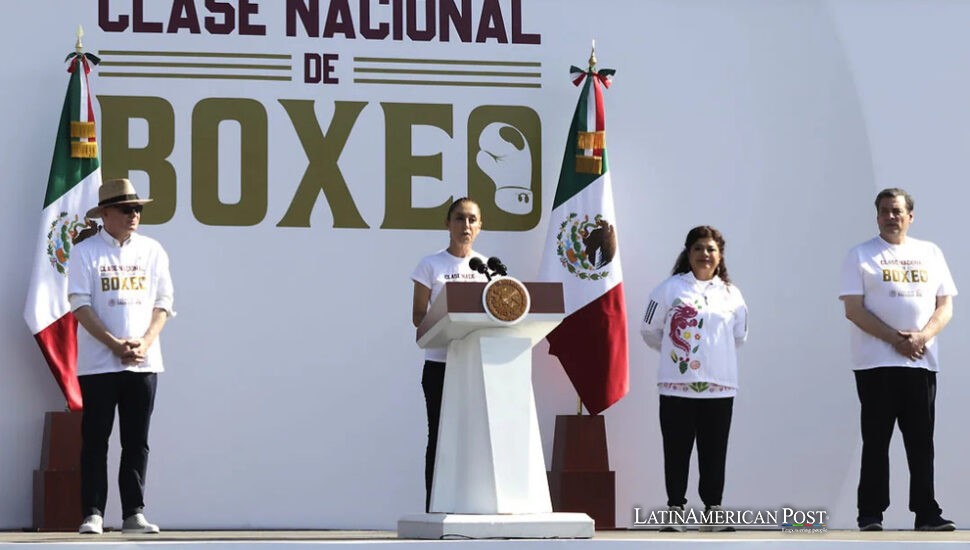Mexico’s Giant Boxing Class Confronts Addiction, Inspires Hope

Mexico saw a wave of excitement after thousands met for a boxing class nationwide. The event included legends such as Óscar de la Hoya. It was intended to showcase the power of sports because sports can guide young people away from common violence plus addiction.
A Punch Against Social Ills
A hot weekend morning saw the Zócalo, Mexico’s grandest public square, become active with gloved fists hitting the air with rhythm. Young and old joined a historical, nationwide boxing class. It aimed to boost exercise, solidarity, and drug abuse prevention. At the helm were boxing greats such as Óscar de la Hoya, Julio César Chávez, Rubén “Puas” Olivares, Humberto “Chiquita” González, and Roberto “Manos de Piedra” Durán, joined by emerging boxing talents like Irma García, Lourdes Juárez, and Yesica Nery. For an uninterrupted hour, the crowd punched, bobbed, and weaved in unison—wearing the colors of the Mexican flag in a striking mosaic of green, white, and red.
The iconic Zócalo was just one focal point; simultaneous boxing classes took place across all 32 states of the country. This substantial demonstration of physical power did surpass simple record demolition. Instead, it aimed to showcase the potential of sports, especially boxing, for constructive impact inside areas troubled by violence and dependency. Organizers offered various justifications for boxing as their focus. Beyond its cultural significance in Mexico (the country has produced over 200 world champions, according to data from the World Boxing Council), boxing is a proven builder of discipline, self-esteem, and resilience—attributes that can help youth resist social pressures and addictions.
Boxing’s potential to deter drug misuse has been documented in various research studies. A systematic review from 2020 in the British Journal of Sports Medicine stated that involvement in organized sports cuts the chance of drug misuse. It supplies good communities besides guidance. The World Health Organization stresses that regular exercise lowers elements that link to mental issues plus drug reliance. Against this backdrop, Óscar de la Hoya’s call to “say no to addictions and yes to boxing” is not just a catchy slogan—it reflects evidence-based strategies emphasizing the protective role of sports in preventing delinquency and drug use.
Building Peace and Healthy Futures
Claudia Sheinbaum, whom they called the country’s leader at the ceremony, talked about the class’s broader importance at the main event in Mexico City. She described boxing as a display of national spirit. She depicted it as a way to construct peace when the world lacks clarity. “This class is a message from Mexico to the world that here we build peace and choose to be a free, independent, and sovereign country,” Sheinbaum declared to the cheering crowd. “The youth of Mexico say no to violence and addictions. Mexico says yes to education, sports, peace, and love.”
In a nation where challenges such as gang-related violence and drug trafficking persist, local governments and community organizations have championed sports programs to channel the energy of at-risk youth.
The National Commission for Physical Culture and Sport (CONADE) reports that 36% of young Mexicans between 12 and 18 participate in athletic activities on a weekly basis—an increase from previous years. Advocates for these programs seek to improve these statistics. They believe open community spaces and athletic complexes deter young people from risky behavior.
Mexico has a substantial boxing history – it holds significant sway. Julio César Chávez achieved fame, and Saúl “Canelo” Álvarez gained global recognition – together, they established boxing as a national feature for many years. Experts point to the physical command and sharp mental focus needed for the sport. The exercise regimens include demanding practice, sustained concentration, and mindful dietary restrictions. Boxing clubs set up a regulated framework, often acting as favorable community settings. This purpose seems especially crucial where there is little domestic or civic care.
Officials report that these programs do more than discover the next global champion. Boxing’s regulated system helps even those who won’t turn pro. For example, goal creation, stress management, and belief enhancement—the methods learned in the boxing gym—can transfer to regular life. Sheinbaum and De la Hoya said such personal development helps young Mexicans avoid aggression and drug misuse.
A United, Active Nation
The national boxing class included more than just punching exercises. Respected figures of the sport showed important techniques – they covered footwork, defensive moves, and combinations. Besides that, they pushed attendees to embrace healthier habits. Although the heat rose, people from children to grandparents continued. They did workouts, plus these required both physical power and mental determination. Organizers gave out water and shared safety advice. They pointed out that hydration, besides good technique, mattered. In addition to the physical test, the occasion made apparent a communal togetherness: diverse individuals located shared purpose in each deliberate punch.
Although various official functions occurred, the Zócalo meeting gained focus because of its unity. The National Palace and Metropolitan Cathedral stood as a backdrop while many attendees moved together with rhythm, indicating a national commitment to health. Once the session was complete, cheers and applause resounded, which confirmed the event was a success. Sheinbaum stated, “When we organize, nothing is impossible. Mexicans have a brave spirit and a sense of justice.”
In the weeks leading up to the event, municipal governments and sports institutions launched social media campaigns urging citizens to register. Some used local community centers for sign-ups; others leveraged local boxing gyms to prepare novices. The anticipation was apparent – this mirrored a general public feeling that sports were not simply amusement but crucial for social development.
New facts from INEGI in Mexico confirmed this hopeful view. In its latest public health and recreation report, 72% of surveyed families agreed that increased access to sports programs could reduce youth involvement in crime and substance abuse. Moreover, 65% felt that community sports events improve neighborhood safety. Large gatherings, like the boxing class, connect different age groups and social circles. They increase understanding, and mold shared standards that praise well-being plus assistance.
Mexico advanced by promoting the sport. It became a priority. This country hosted the National Sports Week and backed top-level training. Obstacles exist: socioeconomic disparity, scarce money for gyms in needy areas, and drug attraction. This nationwide boxing class showed a vital point: dedication to local endeavors unites people for a superior goal.
For most people involved, the reason appeared clear: build a community. Order and help changed hopelessness into optimism. Although a new winner came, joint labor presented a patriotic feeling. It displayed power besides harmony if issues happened. In just an hour, they did more than physical training. They built trust in boxing’s power. It protected kids from danger, focused them on aims, and made them sure to deny wrongdoing.
Also Read: Blood, Pride, and Punches: UFC’s Wild Ride Through Latin America
Beyond that, the function improved a concept that moves past just the boxing area: athletics links, merges dissimilarities and makes acceptance. For the many who took part in this significant lesson, boxing was more than just an activity. It became a sign of being alive, a bond next to the mutual mind that carries Mexico onward.




